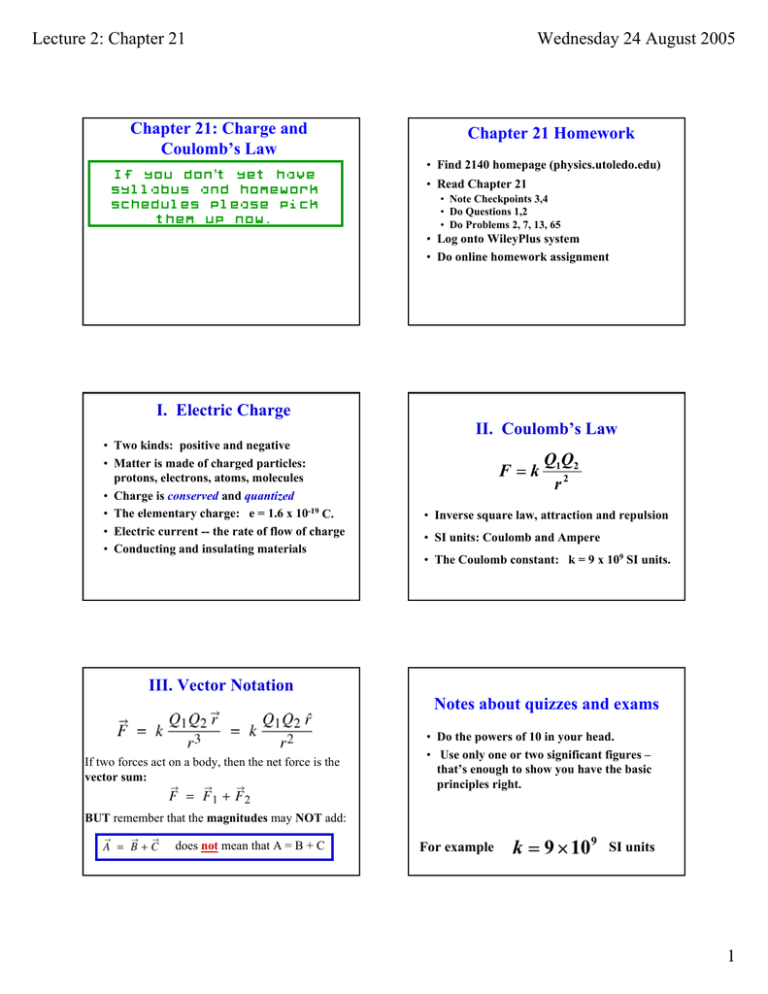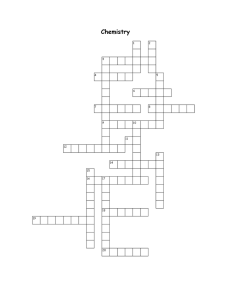Lecture, Ch. 21: Coulomb`s Law
advertisement

Lecture 2: Chapter 21 Chapter 21: Charge and Coulomb’s Law If you don’t yet have syllabus and homework schedules please pick them up now. Wednesday 24 August 2005 Chapter 21 Homework • Find 2140 homepage (physics.utoledo.edu) • Read Chapter 21 • Note Checkpoints 3,4 • Do Questions 1,2 • Do Problems 2, 7, 13, 65 • Log onto WileyPlus system • Do online homework assignment I. Electric Charge • Two kinds: positive and negative • Matter is made of charged particles: protons, electrons, atoms, molecules • Charge is conserved and quantized • The elementary charge: e = 1.6 x 10-19 C. • Electric current -- the rate of flow of charge • Conducting and insulating materials III. Vector Notation If two forces act on a body, then the net force is the vector sum: II. Coulomb’s Law F =k Q1Q2 r2 • Inverse square law, attraction and repulsion • SI units: Coulomb and Ampere • The Coulomb constant: k = 9 x 109 SI units. Notes about quizzes and exams • Do the powers of 10 in your head. • Use only one or two significant figures – that’s enough to show you have the basic principles right. BUT remember that the magnitudes may NOT add: does not mean that A = B + C For example k = 9 × 109 SI units 1 Lecture 2: Chapter 21 Wednesday 24 August 2005 The quantum of charge Moving Charge The world is made of atoms, which are made of protons, neutrons and electrons. • I can charge an object by adding or removing electrons. • When I comb my cat, I move electrons from the fur to the rubber comb, leaving the cat with a net positive charge, and the comb with a negative charge. • Charge conservation means that, if both cat and comb were originally neutral, then • Proton has charge +e. • Electron has charge –e. • Neutron has charge 0. Atom is mostly empty space. Tiny nucleus contains protons, neutrons. Qcat + Qcomb = 0 Fundamental quantum of charge: e = 1.60 × 10-19 C Atomic number and mass number • Z = atomic number = no. of e’s = no. of p’s (so Q=0 for a neutral atom) • A = mass number = no. of protons + no. of neutrons (mp = mn >> me) • NA = Avagadro’s number = 6 × 1023 (number of atoms in one mole ) Example U235 ( 235U ) 92 Two isotopes of uranium: has Z=92, A=235 (92p’s, 92e’s, 143n’s) U238 ( 238U92 ) has Z=92, A=238 (92p’s, 92e’s, 146n’s) Question: How many atoms in 1 kg of U235? Answer: One mole is 235 grams, so 1 kg is 1000/235 = 4.26 moles. The number of atoms in a mole is NA = 6 x 1023 so the answer is NA is defined so that the mass of NA atoms is A grams 4.26 × 6 × 10 23 = 2.6 × 10 24 atoms Another example Coulomb’s Law: Action at a Distance? • Estimate the force on a person who lost electrons from 1 gram of his/her body? • Model body with a ~1 m3 water sphere, • 1 mole of H20 is 18g. • 1 g has n=NA/18 ~ 1022 atoms • Electric charge Q=ne ~ 103 C • Force F=kQ2/r2 ~ 1010 x (103)2 / 12=1016 N Huge! Electrostatic forces are strong. 1m F • One charged object exerts a force on another. • Like charges repel, unlike charges attract. • How can a force be exerted at a distance? • Next chapter: the electric field. 2 Lecture 2: Chapter 21 Wednesday 24 August 2005 This is often written as k = 9 × 4 × 10 −3 = 4 × 10 − 3 N 9 Example 2 What is the net force on the charge q due to the charges Q1 and Q2 placed as shown? q = 1 nC Q1 = 4 µC d d Two charges are separated by 2 m and repel each other with a force of 20 N. If they are moved to a separation of 4 m, what will be the repulsive force? 1. 2. 3. 4. 5. 5N 10 N 20 N 40 N 80 N 0% Q2 = −3 µC 0% 0% 0% Example 2 (cont’d) What is the net force on q? q F1 Q1 θ d F2 d = 3 mm q = 1 nC Q1 = 4 µC d Q2 = −3 µC d = 3 mm 0% N Q 2 9 × 109 × ( 2 × 10 −6 ) 2 F =k 2 = 32 r SI units N Solution Q = 2µC = 2 × 10 −6 C ε 0 = 8.85 × 10 −12 80 Two charges are separated by 3 meters. If each charge is 2 microcoulombs, what is the force by one charge on the other? with the permittivity constant having the value N Example 1 1 40 • The force is inversely proportional to the square of the distance SI units (4πε 0 ) N • If r → 2r then F → F/4 F= k = 8.99×109 ≈ 9×109 5 • F∝ 1/r2 and determines the electrostatic constant 20 • Because space is three-dimensional. Coulomb’s experiment gives F = kQ1Q2/R2 N • True for both electricity and gravity! Why? The Coulomb Law Constants 10 The inverse square law = 1 × 10 +15 × 4 × 10 −15 N = 4 N F2 = k Q2q ( 3 × 10 −6 )(1 × 10 −9 ) = 9 × 109 2 d ( 3 × 10 − 3 ) 2 = 1 × 10 +15 × 3 × 10 −15 N = 3 N G G G F = F1 + F2 2 Q2 F=Fnet Qq ( 4 × 10 −6 )(1 × 10 −9 ) F1 = k 12 = 9 × 109 d ( 3 × 10 − 3 ) 2 2 F = F1 + F2 = 32 + 4 2 = 5 N tan θ = 3 / 4 θ = 37° 3 Lecture 2: Chapter 21 Wednesday 24 August 2005 Example 2 (cont’d) y OR: Q1 d What is the net force on q? q F1 F2 F d Q2 Fx = +4 N Fy = −3 N x No test tomorrow in DC 1019! • For future tests: • Bring PRS unit • No formula sheet • Multiple-choice questions 4





